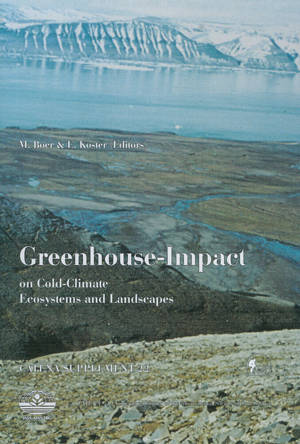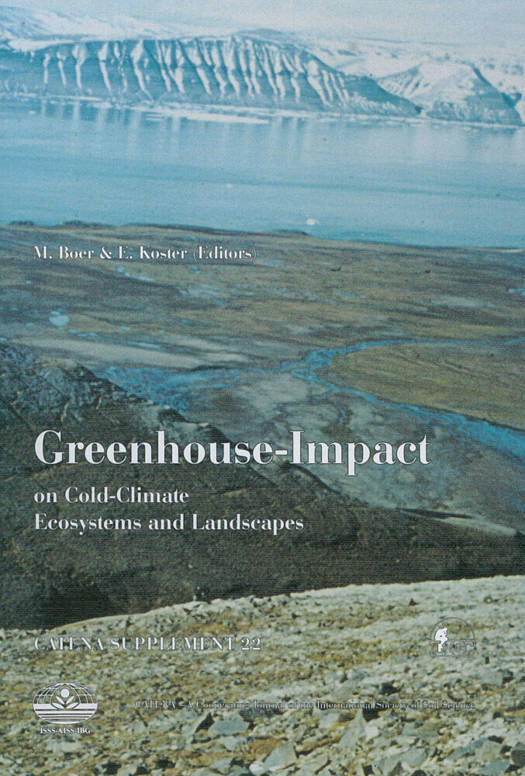
- Retrait gratuit dans votre magasin Club
- 7.000.000 titres dans notre catalogue
- Payer en toute sécurité
- Toujours un magasin près de chez vous
- Retrait gratuit dans votre magasin Club
- 7.000.0000 titres dans notre catalogue
- Payer en toute sécurité
- Toujours un magasin près de chez vous
Greenhouse-Impact on Cold-Climate
Ecosystems and Landscapes Selected papers of the European Conference on Landscape Ecological Impact of Climatic Change, Lunteren, The Netherlands, December 3-7, 1989
59,95 €
+ 119 points
Description
Climatic change and sea level rise, which are thought to result from the enhanced greenhouse forcing of the steadily increasing concentrations of atmospheric carbon dioxide and other so-called greenhouses gases such as methane (CH4), nitrous oxide (N20) and chlorofluorocarbons (CFC s) has become a topic of major scientific and political concern. The global dimension of the problem and the potentially hazardous implications are leading to calls for a large research effort to quantify the nature, magnitude and rate of climate change and sea level rise, the impact on the natural environment and society, as well as the feedbacks to the global climate system. Outlines for this research effort have been formulated, amongst others, by the International Geosphere-Biosphere Programme (1GBP 1990) of the International Council of Scientific Unions (ICSU). The WMO/UNEP Intergovernmental Panel on Climate Change (IPCC) recently predicted a rate of increase of global mean temperature during the next century of 0.1 to 0.3°C per decade with an uncertainty range of 0.2 to 0.5°C per decade (HOUGHTON et al. 1990). Changes in all climate variables (e.g. winds, precipitation, evaporation) will occur in parallel with this global-mean warming although varying substantially from region to region and from season to season (HULME et al. 1990). Current climate scenarios show that large latitudinal differences are likely to occur, which have the feature of a smaller temperature increase of half the global mean in the tropical regions and a larger increase of twice the global mean in high-latitude regions (Houghton et al. 1990). Changes in mean annual temperatures of a comparable magnitude, and sometimes even of a similar rate of change (e.g. during the Younger Dryas Period, ± 11000-10000 BP), as those envisaged to result from a doubled greenhouse forcing of the atmosphere, have occurred in the past (Berger & Labeyrie 1985) and may serve as analogues for future changes. From paleoclimatic and paleo-environmental constructions we know that the major changes in the geological past and the minor deviations since historical times (e.g. Climate Optimum of the Middle ages, Little Ice age), have caused significant alteration in the spatial distribution of plant and animal species (e.g. Huntley & Birks 1983, Birks 1990), in the frequency and intensity of geomorphological processes (e.g. Derbyshire 1976), and in land use (e.g. Parry et al. 1988). A number of recent experiments, in which present climate - life zone relationships have been extrapolated towards the warmer, hypothetical high-C02 situation, have shown a large mismatch between the present distribution of vegetation types or life zones and the future bioclimatic zonation (e.g. Emanuel et al. 1985, Rizzo & Wiken 1989, Ozenda & Borel 1990). Global climate warming of several degrees Celcius over a time span of several decades to a century may thus be expected to have a pronounced impact on the structure and functioning of terrestrial ecosystems and landscapes.
Spécifications
Parties prenantes
- Editeur:
Contenu
- Nombre de pages :
- 151
- Langue:
- Anglais
- Collection :
- Tome:
- n° 22
Caractéristiques
- EAN:
- 9783510653638
- Format:
- Livre relié
- Dimensions :
- 170 mm x 240 mm
- Poids :
- 470 g

Les avis
Nous publions uniquement les avis qui respectent les conditions requises. Consultez nos conditions pour les avis.





